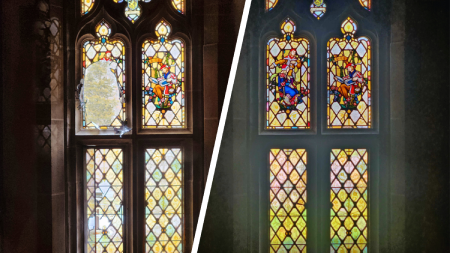Meadow Brook Hall’s historic stained-glass windows have been restored to their original glory – and location within the mansion’s two-story Gothic-inspired Ballroom, following a shocking act of vandalism that occurred in February 2025 and an incredible six-month restoration journey.
The stained-glass windows are original to the National Historic Landmark when it was completed in 1929 and were already in need of restoration when the damage occurred. Meadow Brook staff had previously secured a grant to support the project, but costs soared as a result of the vandalism. Conservators worked to fit the broken pieces together and reassembled much of the original materials.
“The restoration of our windows has been an emotional journey for so many members of our community,” said Meadow Brook Executive Director Bill Matt. “We had never before experienced an act of vandalism of this caliber. The outpouring of support we received has been incredible and we are grateful to the many people who contributed their time, energy and financial support to ensure that these beautiful artifacts are back where they belong, fully restored to their original brilliance.”
New additions include heavy-duty plexiglass panels to the lower exterior sections, which will protect the windows from UV damage, weather and any small abrasions from gardening, routine maintenance work and minor accidents. The team added a patina finish to the metal frames, which mimics the natural aging process to create a weathered appearance, so the new frames will blend in with Meadow Brook’s architecture.
Oakland University Police investigated the vandalism and worked with the media to help identify a suspect, who was arrested and arranged as a result of an anonymous tip.
Following the vandalism, Meadow Brook launched The 1929 Club, a monthly giving club that nods to the year Meadow Brook Hall was founded. The program is for members committed to giving $19.29 a month to support the cultural institution and kicked off by focusing on the extra $35,000 in funds needed to restore the windows. To make a gift to Meadow Brook or to join The 1929 Club, visit meadowbrookhall.org/support.
The historic stained-glass windows were custom created and designed for the estate’s two-story Gothic-inspired ballroom. They depict scenes of the arts, including music, literature and entertainment, and drama. The windows were designed so they could be viewed without distortion from both sides (inside and outside), which is slightly unusual because stained glass is typically viewed best from the inside and not the exterior.
Meadow Brook Hall is fully self-supporting, relying on touring, special events and philanthropy for the preservation and interpretation of this National Historic Landmark. For more information, call (248) 364-6200 or visit meadowbrookhall.org.


 August 13, 2025
August 13, 2025







